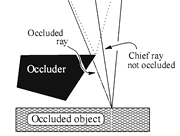Yoav Y. Schechner: Research
Depth from defocus vs. Stereo

Depth from Focus (DFF) and Depth from Defocus (DFD) methods are theoretically unified with the geometric triangulation principle. We show that fundamentally, the depth sensitivities of DFF and DFD are not different than those of stereo (or motion) based systems having the same physical dimensions (under the geometric optics approximation). Contrary to common belief, DFD does not inherently avoid the matching (correspondence) problem. Basically, DFD and DFF do not avoid the occlusion problem any more than triangulation techniques, but they are more stable in the presence of such disruptions.
The fundamental advantage of DFF and DFD methods is the two-dimensionality of the aperture, allowing more robust estimation. We analyze the effect of noise in different spatial frequencies, and derive the optimal changes of the focus settings in DFD. These results elucidate the limitations of methods based on depth of field and provide a foundation for fair performance comparison between DFF/DFD and shape from stereo (or motion) algorithms.
Publications
- Yoav Y. Schechner and Nahum Kiryati, “Depth from defocus vs. stereo: How different really are they?,” International Journal of Computer Vision 89, pp. 141-162 (2000).
- Yoav Y. Schechner, Nahum Kiryati and Joseph Shamir, “Multi-valued images and their separation,” Multi-Image Analysis, Lecture Notes on Computer Science Vol. 2032, pp. 129-141 (2000), Editors: R. Klette, T. Huang, and G. Gimel'farb.
- Yoav Y. Schechner and Nahum Kiryati, “The optimal axial interval in estimating depth from defocus,” Proc. ICCV, pp. 843-848 (1999).
- Yoav Y. Schechner and Nahum Kiryati, “Depth from defocus vs. stereo: How different really are they?,” Proc. ICPR, pp. 1784-1786 (1998).




